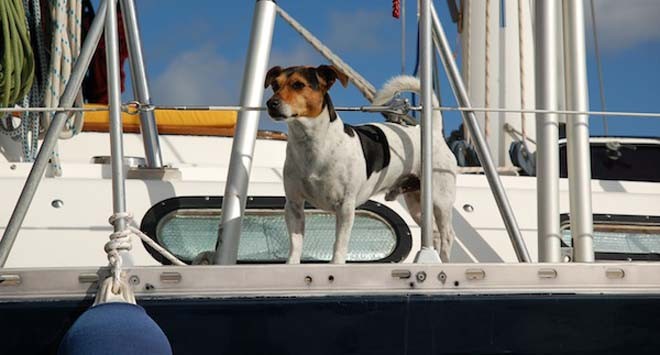The Ten Golden Watchkeeping Rules
by Captain John Jamieson on 25 May 2011

Watch keeping skills - alertness is the key SW
How good are you at keeping watch? What makes a valuable underway watchstander? Are you wondering why you weren't invited back after that last passage? Here Captain John Jamieson gives ten golden rules about how to be the best watch keeper and a good friend to your crew mates (even if there is only one). Check them out to see whether your watch keeping skills need upgrading:
The mandatory skills for a watch-keeper are to be able to scan the horizon with binoculars, track sighted vessels and adjust sails and rigging.
Here are the ten top rules to get yourself prepared to stand watch aboard any vessel, anywhere in the world:
Rule 1: Get Rest:
For day watches, take a short twenty minute nap within an hour of your watch. This will keep you alert for several hours. If you have a late night watch that extends into the early morning hours, hit the bunk early to be well rested for watch.
Rule 2: Wear the Right Gear:
Layer for warmth on a cold watch. Bring foul weather gear with you no matter the current weather. Squalls can come out of nowhere and you want to be ready.
Rule 3: Hydrate and Snack:
Dehydration causes seasickness and fatigue. Drink water and increase your intake of minerals and vitamin C (buy packets, such as 'Emergen-C'). To keep alert, eat light snacks on watch instead of heavy meals.
Rule 4: Follow the Skipper's Standard Operating Procedures (SOP):
Most skippers have standard operating procedures that tell you when to keep the log (once an hour or once per watch), when to wake him or her, and safety procedures on watch. Alert the skipper if you are in doubt or have a question that affects the safety of the crew.
Rule 5: Scan the Horizon:
Use binoculars to scan 360 degrees around the horizon. On a black night, the horizon can be tough to find. Look just beneath the lowest layer of stars. Scan just above the line of the horizon. Studies have shown that this technique helps you pick out hard-to-see objects in low light conditions.
Rule 6: Check the Course:
It's easy to forget about the course if you're on autopilot. Those silent crewmembers do tend to wander sometimes like a sailor with one-too-many rum punches! Check the compass course every 30 minutes to make sure you stay on the sailing course.
Rule 7: Use Electronic Tools:
International law makes it quite clear that all lookouts must use electronics--if installed--to help avoid collisions. This includes AIS and radar. Many vessels have stand-alone radars or integrated chart plotter-radar systems aboard. Switch to the radar mode to scan for vessels you may have missed with binoculars. Use both distant and close range scales.
Rule 8: Keep the Log:
Log navigation, weather, and engineering data into the ships log at least once per watch. Write down Latitude and Longitude, course, speed over ground, sails hoisted, and weather data. Keep a separate engineering log section for water temp, oil pressures, amperage, fuel tank level, and fresh water tank level.
Rule 9: Put on the Kettle:
Keep on good terms with any oncoming watchstander with a hot pot of water, ready to pour into a mug for coffee, tea or soup. He or she will appreciate this kindness more than you can imagine.
Rule 10: The all-important Briefing:
Before you go below, give your relief an easy-to-remember summary. Has the wind shifted? What speed are you making good? Have you sighted any vessels and where are they now? What weather can he or she expect on watch? Keep it simple and clear.
Practice these secrets of collision avoidance and watchstanding from the moment you cast off that last line. They will keep you, your crew and the yacht safe and sound on the waters of the world to enjoy safe, worry-free sailboat cruising.
These tips are from Captain John Jamieson's highly popular eight-part 'Offshore Sailing' series, which you will find at www.skippertips.com In this series Captain John, with 25+ years as a master mariner, shows you the skills you need for safer sailing anywhere in the world.
......................
Letter from reader:
Sender: Alex Blackwell
Message: Hi there
This is an article that is very close to every long distance cruiser's heart. I heartily agree with all the points raised - even with putting on the kettle towards the end of each watch.
However, I am surprised that John did omit what on our boat is the most important rule of all:
The number one rule of sailing (and watch keeping) is: Stay on the boat.
It may appear self evident, but when sailing short handed, or in any schedule when only one person is on watch, the others have no way of knowing if there is a MOB situation.
We therefore have a sub-rule that nobody goes out on deck without being tethered while at sea. We have the first pad eye positioned just below the companionway and have a tether attached for an emerging person to clip in to without fail. Jack lines and pad eyes are then strategically positioned from bow to stern. A correlary to this sub-rule is that nobody leaves the cockpit without another person being on deck.
If you want to link to this article then please use this URL: www.sail-world.com/83922